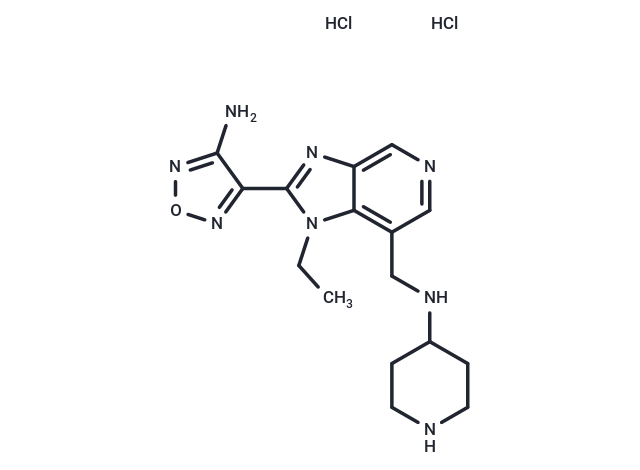Shopping Cart
- Remove All
 Your shopping cart is currently empty
Your shopping cart is currently empty

SB-747651A dihydrochloride is a chemical compound that serves as an ATP-competitive inhibitor for mitogen- and stress-activated kinase 1 (MSK1), featuring an IC50 of 11 nM. Additionally, this compound effectively inhibits PRK2, RSK1, p70S6K, and ROCK-II, showcasing its potential in inflammation research [1].

| Pack Size | Price | Availability | Quantity |
|---|---|---|---|
| 1 mg | $67 | In Stock | |
| 5 mg | $157 | In Stock | |
| 10 mg | $231 | In Stock | |
| 25 mg | $388 | In Stock | |
| 50 mg | $553 | In Stock | |
| 100 mg | $750 | In Stock | |
| 500 mg | Inquiry | In Stock | |
| 1 mL x 10 mM (in DMSO) | $172 | In Stock |
| Description | SB-747651A dihydrochloride is a chemical compound that serves as an ATP-competitive inhibitor for mitogen- and stress-activated kinase 1 (MSK1), featuring an IC50 of 11 nM. Additionally, this compound effectively inhibits PRK2, RSK1, p70S6K, and ROCK-II, showcasing its potential in inflammation research [1]. |
| In vitro | SB-747651A dihydrochloride (5 μM; neutrophils) modulates neutrophil behavior in response to the CXCL2 chemotactic gradient by influencing CXCL2-induced intraluminal crawling in a Mac-1-dependent manner, obstructing the movement of adherent neutrophils to optimal emigration sites. It significantly prolongs the transmigration and detachment times of neutrophils, affecting their transendothelial migration. Additionally, it slows the migration velocity of extravascular chemotaxing neutrophils without altering their directionality towards CXCL2 signals. |
| In vivo | SB747651A (3 mg/kg; intrascrotal injection) dihydrochloride significantly increases neutrophil adhesion between 3.5 and 4.5 hours after CXCL2 stimulation [3]. Additionally, the same compound administered intraperitoneally (i.p.) at the same dosage enhances neutrophil extravasation by augmenting neutrophil emigration at the 3 and 4-hour marks in a mouse peritonitis model of acute inflammation [3]. Experiments were conducted on male C57BL/6N mice aged 8 to 16 weeks, confirming that a 3 mg/kg intrascrotal injection results in heightened neutrophil adhesion following CXCL2 stimulation. |
| Molecular Weight | 415.32 |
| Formula | C16H24Cl2N8O |
| Cas No. | 1781882-72-1 |
| Smiles | Cl.Cl.CCn1c(nc2cncc(CNC3CCNCC3)c12)-c1nonc1N |
| Storage | Powder: -20°C for 3 years | In solvent: -80°C for 1 year | Shipping with blue ice. | |||||||||||||||||||||||||||||||||||
| Solubility Information | DMSO: 50 mg/mL (120.39 mM), Sonication is recommended. | |||||||||||||||||||||||||||||||||||
Solution Preparation Table | ||||||||||||||||||||||||||||||||||||
DMSO
| ||||||||||||||||||||||||||||||||||||

Copyright © 2015-2025 TargetMol Chemicals Inc. All Rights Reserved.